Known as the “Bluegrass State,” Kentucky is famous for its vast green pastures and horses. However, it is much more than we first expect. Kentucky is bordered by three major rivers — the Mississippi, Ohio, and Big Sandy rivers — that are home to many fascinating animals. The state also includes a national park and two national forests and has been the center of several successful reintroduction programs, particularly elk and wild turkeys. These are amongst the largest mammals and birds in the state, but just what other animals call Kentucky home? Join us as we discover the largest animals in Kentucky and where you’ll find them!
1. Largemouth Bass
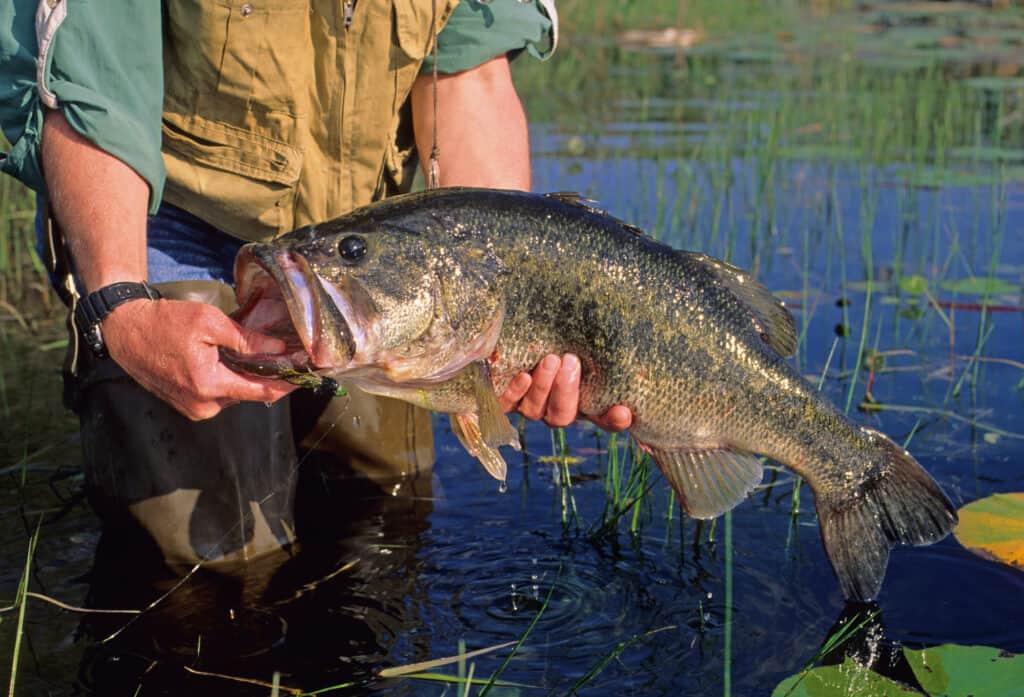
Largemouth bass are carnivorous freshwater fish and live in lakes, ponds, and rivers.
©iStock.com/stammphoto
Largemouth bass are the largest fish in Kentucky, with a record size of 22 pounds 4 ounces, and a state record of 14 pounds 9.5 ounces. Capable of reaching almost 30 inches, largemouth bass are extremely popular with anglers. Largemouth bass has a greenish-grey color, with black blotches forming a line down its flank. They are carnivorous freshwater fish and live in lakes, ponds, and rivers. They prey on a wide range of fish, such as bluegill, yellow perch, trout, and shiners. However, they also eat snails, frogs, snakes, and small birds. Largemouth bass are found in most major lakes in Kentucky, with Dale Hollow Lake, Green River Lake, and Herrington Lake being popular spots.
2. American Black Bear
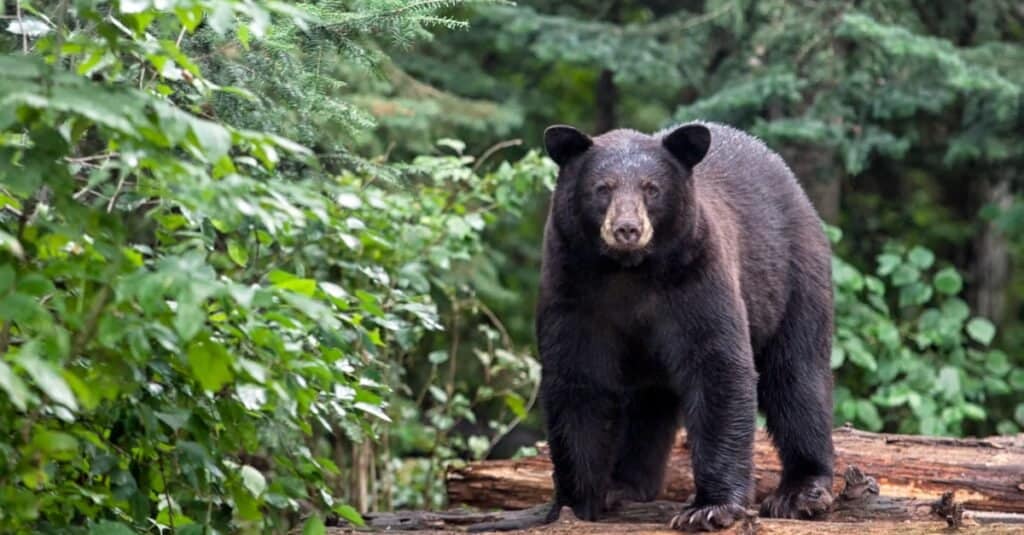
The American black bear can run up to 40mph and weighs approximately 550 pounds.
©iStock.com/Lynn_Bystrom
One of the largest animals in Kentucky is the American black bear, which weighs approximately 550 pounds. They are endemic to North America but are the most widely distributed bear species. Black bears prefer to live in areas where there is plenty of thick vegetation for them. Their preferred areas are woodlands and mountainous regions at elevations between 1,300 and 9.800 feet. The bear population is increasing in Kentucky, and the Black Mountain region is one of the state’s best places to see them. Black bears are omnivorous and eat a range of grass, fruit, seeds, insects, and mule and white-tailed deer fawns.
3. Sandhill Crane
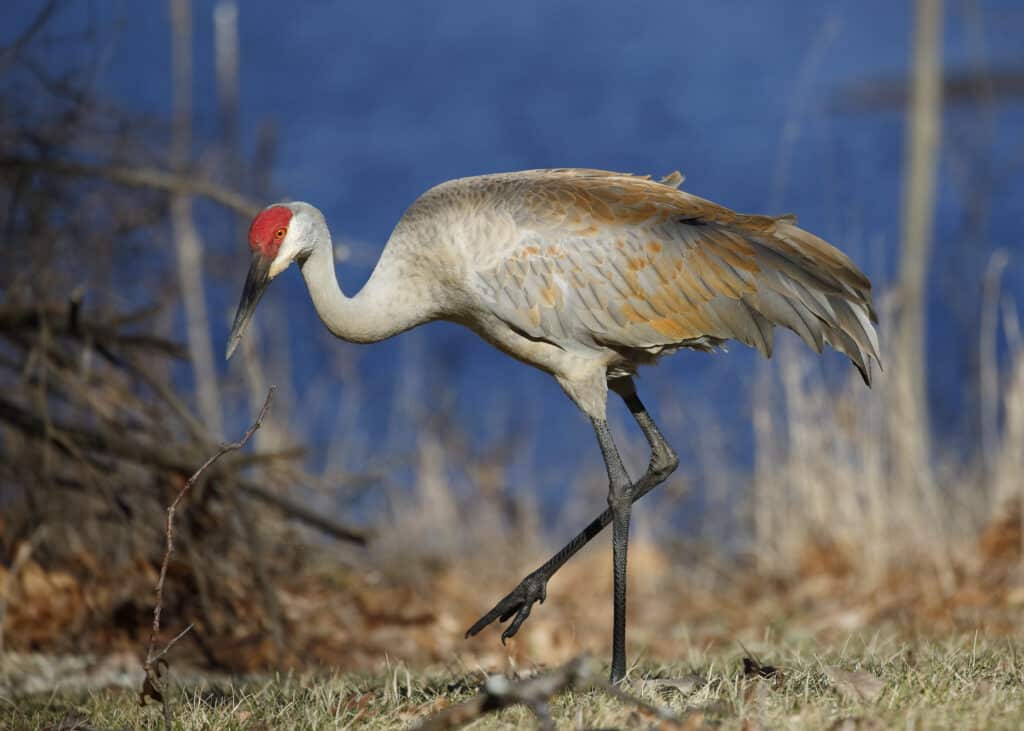
Sandhill cranes live in freshwater habitats such as swamps, marshes, and river basins.
©Brian Lasenby/Shutterstock.com
Standing up to 4 feet 6 inches and with a wingspan that can reach 7 feet 7 inches, sandhill cranes are undoubtedly huge birds. They have a distinctive appearance with grey bodies, a red crown on their head, and a long pointed bill. Sandhill cranes live in freshwater habitats — particularly swamps, marshes, and river basins, where there is plenty of food for them to forage. They are omnivores and eat various seeds, berries, insects, snails, and amphibians. Sandhill cranes are migratory birds, and Kentucky has long been on their annual migration route. Every year, thousands of them descend on Barren River Lake. Although they usually live alone or in pairs for much of the year, they live in huge communal flocks during migration.
4. Timber Rattlesnake

Timber rattlesnakes are highly venomous but rarely attack without giving plenty of warning first.
©Frode Jacobsen/Shutterstock.com
There are four venomous snakes in Kentucky. The largest is the timber rattlesnake, which typically reaches 3 to 5 feet long. These heavy-bodied snakes are yellowish brown with dark brown or black crossband markings that often have zig-zag edges. Timber rattlesnakes are highly venomous but have a fairly mild temperament and rarely attack without giving plenty of warning first. They mainly live in thick forest regions, although females prefer areas with rocky outcrops so they can bask in the sun. Although once found statewide, they are now only found in the thickest forests. The exceptions are the Bluegrass region and northern Kentucky, where they are absent.
5. Giant Water Bug
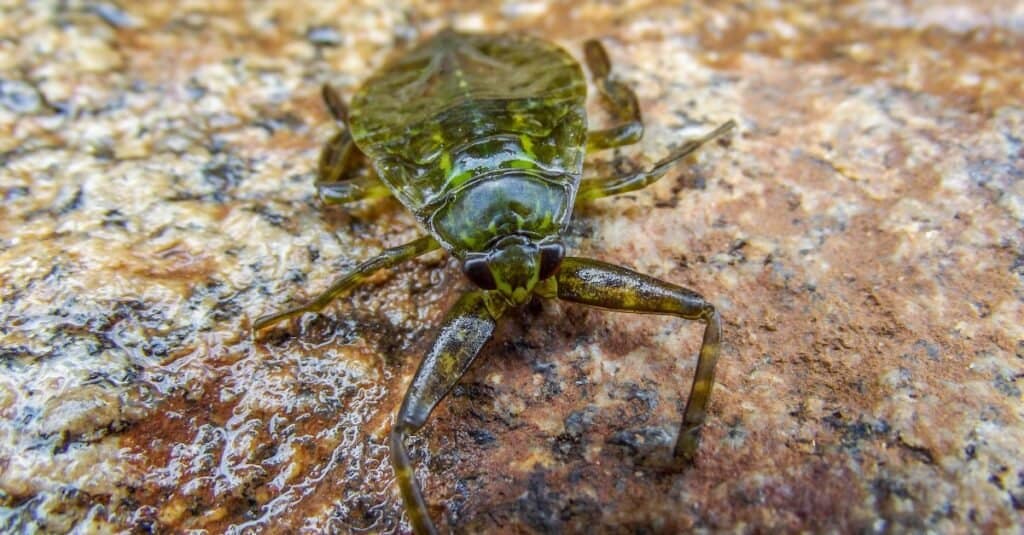
Giant water bugs live in ponds, streams, and marshes, where they prey on fish, snails, amphibians, and crustaceans.
©iStock.com/Eric Kukulowicz
The largest insects in Kentucky are giant water bugs, members of the Belostomatidae family group. Giant water bugs have flattened oval-shaped bodies. The largest species can reach 4.5 inches long. Giant water bugs live in ponds, streams, and marshes, where they prey on fish, snails, amphibians, and crustaceans. They are also commonly known as toe-biters, and this is because they can deliver an incredibly painful bite when disturbed or handled. Giant water bugs are found all over Kentucky but are most common in the state’s southern region.
6. Blue Catfish
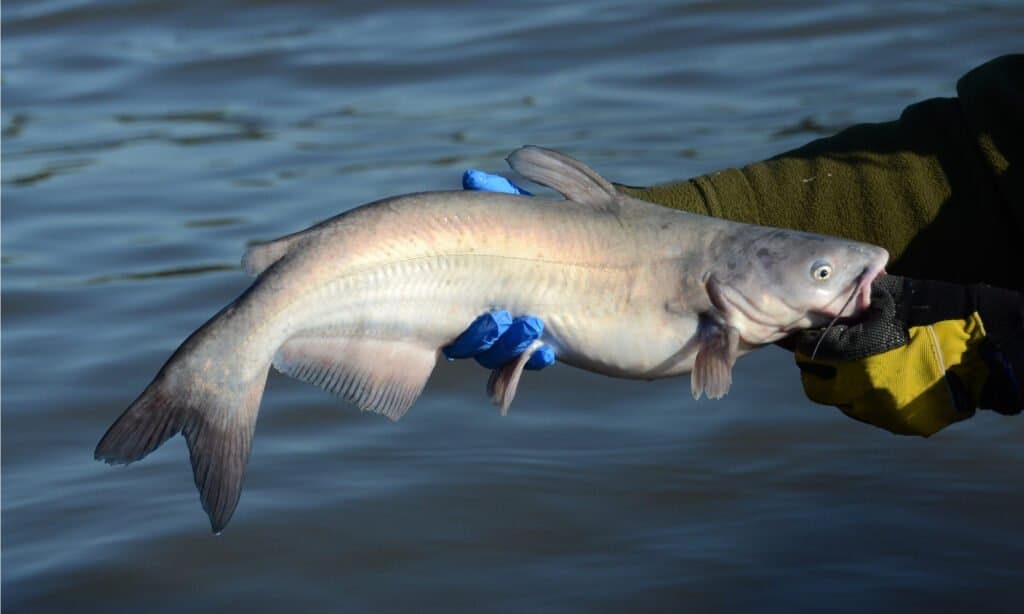
Blue catfish are predatory fish that are classed as a pest in many places.
©M Huston/Shutterstock.com
The largest species of catfish in North America and one of the largest fish in Kentucky is the mighty blue catfish, which can reach 150 pounds. Blue catfish are predatory fish that are classed as a pest in many places, and they are opportunistic feeders and eat pretty much anything they come across. Although blue catfish are primarily found in freshwater lakes and rivers, they are also noted for their ability to tolerate brackish water, allowing them to survive in bays and estuaries. They are widely distributed across Kentucky. However, places such as Barren River Lake, Buckhorn Lake, and Rough River Lake are hailed as prime spots to land them.
7. Bald Eagle

Bald eagles are migratory, and the best time to see them in Kentucky is between September and March.
©PHOTOOBJECT/Shutterstock.com
The largest bird in Kentucky is the stunning bald eagle with a massive wingspan of up to 7 feet 7 inches. These huge birds are easily recognizable by their appearance, including a dark brown body with a white head and tail. Bald eagles are sea eagles and typically live near large bodies of water such as lakes and coastlines. They predominantly eat fish, which they scoop straight out of the water with their sharp talons. Bald eagles are migratory, and the best time to see them in Kentucky is during the winter between September and March. Kentucky Lake is one of the prime bird-watching spots in the state to see them.
8. Grey Rat Snake

Grey rat snakes are also called chicken snakes because they tend to break into chicken coops.
©Jay Ondreicka/Shutterstock.com
One of the most widespread animals in Kentucky is the grey rat snake, the largest snake in the state. Grey rat snakes are 3.25-6 feet long and are typically grey, brown, or white with darker blotches on them, although some can be completely black. Grey rat snakes are also called chicken snakes because they tend to break into chicken coops. However, they also prey on rodents, birds, lizards, and frogs. They are not venomous and kill their prey by constriction. Grey rat snakes are highly adaptable and live in various habitats such as forest edges, parks, grasslands, and swamps. They are also semi-arboreal and can often be found hanging out in trees.
9. Wild Turkey

Wild turkeys are abundant in the state of Kentucky.
©iStock.com/Robert Winkler
There were estimated to be around 250,000 to 300,000 wild turkeys widespread across all 120 counties of Kentucky in 2021. The Eastern turkey, the most common of the five subspecies of turkeys in North America, is native to the state. Eastern turkeys are large upland ground birds that have a 4.1-4.9-foot wingspan, can grow 30 to 49 inches long and weigh from 5.5 to 24 pounds. The females are smaller and typically weigh around eight pounds less than the males. Despite their size, these turkeys are fast and agile fliers. They are omnivores and forage for food early mornings and late afternoons. Wild turkeys eat acorns and nuts from trees including hazel, chestnut, hickory, and pine. Sometimes they consume amphibians, salamanders, snakes, and lizards. Eastern turkeys are nonmigratory birds and during fall and winter months they may transition to areas in their habitats that contain bigger trees and closed canopies for protection from the cold.
10. White-Tailed Deer
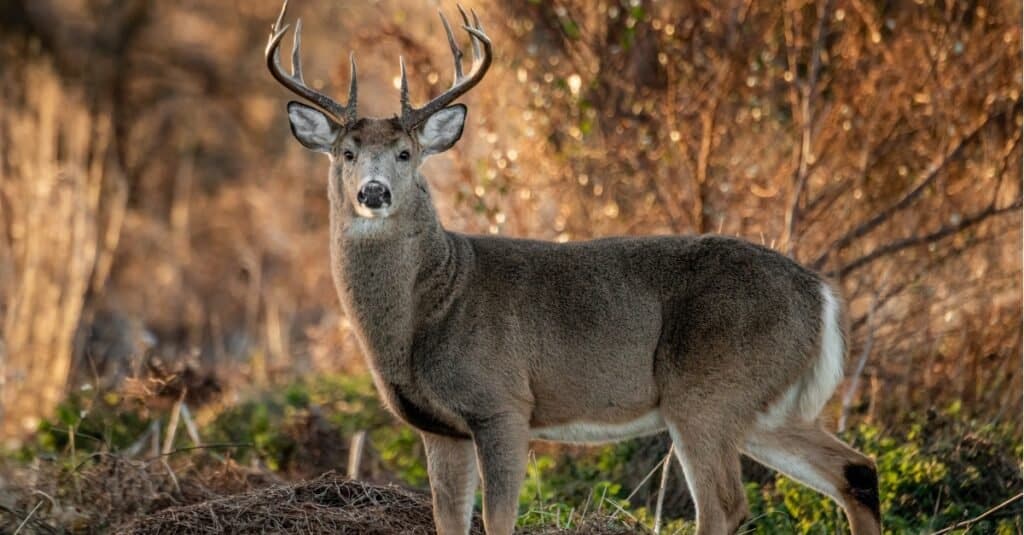
The white-tailed deer has a more red tint to its coat in the spring and a deeper brown in colder months.
©iStock.com/Harry Collins
One of the largest animals in Kentucky is the white-tailed deer. There are around 1 million deer in the state and all are white-tailed. Males (bucks) typically weigh between 150 to 300 pounds and females (does) generally weigh 88 to 198 pounds. White-tailed deer are 1.7-to-3.9-feet tall. They are capable of running up to 30 miles per hour and leaping up to 10 feet in the air. They have been observed swimming up to 13 miles per hour. These deer mainly eat grass, weeds, and flowers. White-tailed deer are usually a tan or reddish-brown color in the spring. As the weather becomes colder, their coat begins to change to a deeper brown. These deer have white on their throats, under their eyes, and on the underside of their tail.
11. Elk

Elk are the second-largest members of the deer family, standing up to 4 feet 11 inches at the shoulder.
©Cody Linde/Shutterstock.com
The largest animal in Kentucky is the massive elk, also known as the wapiti. Elk are the second largest members of the deer family. They stand up to 4 feet 11 inches at the shoulder, weighing 375 to 1,100 pounds. Elk typically live in forests and can be seen in large herds comprising several hundred individuals. However, for much of the year, the males and females remain separate, with females and calves living in one herd and males living together in “bachelor herds.” The two come together during the breeding season known as the rut. Elk are widespread across the eastern regions of Kentucky, with South Fork Elk View in Breathitt County being one of the best places to see them.
Summary of the 11 Largest Animals in Kentucky, and Where You’ll Find Them
Here’s a recap of the 11 biggest animals found in Kentucky that we took a look at.
| Number | Animal | Size | Range in Kentucky |
|---|---|---|---|
| 1 | Largemouth Bass | Record size of 22 pounds 4 ounces; state record of 14 pounds 9.5 ounces | Most major lakes, especially Dale Hollow Lake, Green River Lake, and Herrington Lake |
| 2 | American Black Bear | Weigh around 550 pounds | Increasing; best seen in Black Mountain region |
| 3 | Sandhill Crane | Height: up to 4 feet 6 inches; Wingspan: can reach 7 feet 7 inches | Thousands descend on Barren River Lake during annual migration |
| 4 | Timber Rattlesnake | Reaches 3-5 feet long | Once statewide, now only in the thickest forests |
| 5 | Giant Water Bug | Can reach 4.5 inches long | All over Kentucky; most common in the state’s southern region |
| 6 | Blue Catfish | Can reach 150 pounds | Widely distributed across the state; especially Barren River Lake, Buckhorn Lake, and Rough River Lake |
| 7 | Bald Eagle | Wingspan: up to 7 feet 7 inches | Kentucky Lake is one of the prime bird-watching spots. |
| 8 | Grey Rat Snake | 3.25-6 feet long | One of the most widespread animals in Kentucky |
| 9 | Wild Turkey | Wingspan: 4.1-4.9 feet; Length: 30-49 inches; Weight: 5.5-24 pounds | Throughout all 120 counties |
| 10 | White-Tailed Deer | Height: 1.7-3.9 feet; Weight: Males are 150-300 pounds and females are 88-198 pounds | Around 1 million deer in the state |
| 11 | Elk | Height: up to 4 feet 11 inches at the shoulder; Weight: 375-1,100 pounds | Widespread across the eastern regions of Kentucky, especially South Fork Elk View in Breathitt County |
The photo featured at the top of this post is © Cornelius Doppes/Shutterstock.com
Sources
- Wikipedia, Available here: https://en.wikipedia.org/wiki/List_of_birds_of_Kentucky
- University of Kentucky Entomology, Available here: https://www.uky.edu/Ag/CritterFiles/casefile/insects/bugs/giantwater/giantwater.htm
Thank you for reading! Have some feedback for us? Contact the AZ Animals editorial team.






